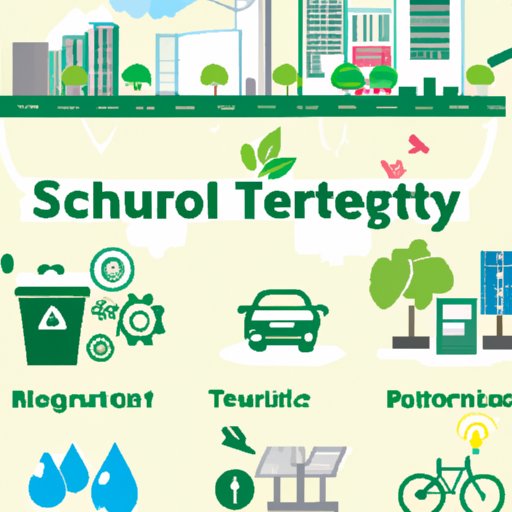Introduction
In recent years, human activities have caused severe environmental problems, including climate change, air pollution, water pollution, and depletion of natural resources. As a result, it is essential that we take action to reduce our environmental impact and protect the planet. Fortunately, there are many ways that technology can be used to help save the environment.
Exploring Renewable Energy Sources
Renewable energy sources, such as solar, wind, geothermal, and biomass, are becoming increasingly popular as an alternative to traditional fossil fuels. These sources of energy are not only better for the environment, but they can also be more cost-effective in the long run. Additionally, renewable energy sources have the potential to create jobs and stimulate economic development.
To make full use of renewable energy sources, technologies such as remote sensing can be used to identify areas with the most potential for development. For example, drones can be used to map out locations that may be suitable for solar panels or wind turbines. Additionally, computer simulations can be used to determine the best locations for installation and predict future energy production.
Improving Efficiency of Transportation
Transportation is one of the leading causes of air pollution and greenhouse gas emissions. Fortunately, there are many ways that technology can be used to reduce emissions from transportation. Electric vehicles, for example, produce significantly fewer emissions than their gasoline counterparts. Additionally, ride-sharing apps such as Uber and Lyft can help reduce the number of cars on the road.
Individuals can also take steps to reduce their own transportation emissions. For example, using public transportation or biking instead of driving can help reduce emissions. Additionally, carpooling and using fuel-efficient vehicles can also help reduce emissions.
Developing Smart Buildings
Smart building technologies can help reduce energy consumption in homes and offices. For example, automated lighting systems can turn lights off when they are not in use, and automated heating and cooling systems can adjust temperatures based on occupancy. Additionally, smart windows can help regulate indoor temperatures and reduce the need for air conditioning.
Smart appliances can also help reduce energy consumption. Smart thermostats, for example, can learn user preferences and automatically adjust settings to optimize energy usage. Additionally, smart meters can provide real-time updates on energy usage and help people manage their energy consumption.
Automating Waste Management
Waste management is another important area where technology can be used to help save the environment. Automated waste management systems can help reduce the amount of waste sent to landfills by sorting through waste and recycling materials that can be reused or repurposed. Additionally, sensors and cameras can be used to detect when bins are full, so that they can be emptied more efficiently.
Robots can also be used to automate the process of collecting and sorting waste. For example, robotic arms can be used to pick up recyclable items and place them into designated bins. Additionally, robots can be used to compact waste, which can help reduce the amount of space needed for storage.
Promoting Sustainable Agriculture
Technology can also be used to help farmers adopt more sustainable practices in their production methods. For example, sensors can be used to monitor soil conditions and provide data-driven insights on how to optimize crop yields. Additionally, drones can be used to collect data on crop health and detect pests or diseases before they become too serious.
Robots can also be used to automate certain tasks on farms, such as harvesting and weeding. Additionally, artificial intelligence can be used to analyze large amounts of data and provide farmers with recommendations on how to improve their operations. These technologies can help farmers increase yields while reducing their environmental impact.
Increasing Access to Clean Water
Clean water is essential for life, yet many people around the world lack access to safe drinking water. Fortunately, there are many ways that technology can be used to increase access to clean water resources and reduce water waste. For example, sensors can be used to detect leaks in pipes and alert authorities to fix them quickly.
Additionally, desalination plants can be used to convert seawater into freshwater, thus providing an additional source of clean water. Furthermore, wastewater treatment plants can be used to purify wastewater and return it to the environment in a safe and sustainable way.
Conclusion
In conclusion, technology can be used to help save the environment in many different ways. From exploring renewable energy sources to improving transportation efficiency, developing smart buildings, automating waste management, promoting sustainable agriculture, and increasing access to clean water, technology can play an important role in protecting the planet. We encourage readers to use the information provided to make a positive impact on the environment.
(Note: Is this article not meeting your expectations? Do you have knowledge or insights to share? Unlock new opportunities and expand your reach by joining our authors team. Click Registration to join us and share your expertise with our readers.)
